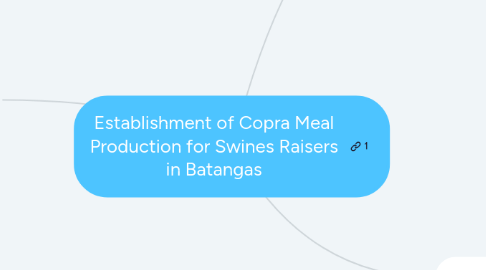
1. CH3: Technical Feasibility
1.1. Technical Product Description:
1.1.1. Product/Service Description:
1.1.1.1. Organic Feed substitute for artificial feeds for poultry,boilers, and aquatic animals.
1.1.2. Product/Service Properties:
1.1.2.1. Physical:
1.1.2.1.1. Powder
1.1.2.2. Chemical:
1.1.2.2.1. Carbohydrates 24.23 (not the same as source listed) Sugars 6.23 Dietary fiber 9 Fat 33.49 Protein 3.33 g Vitamins Quantity%DV† Thiamine (B1) 6% 0.066 mg Riboflavin (B2) 2% 0.02 mg Niacin (B3) 4% 0.54 mg Pantothenic acid (B5) 20% 1.014 mg Vitamin B6 4% 0.05 mg Vitamin C 4% 3.3 mg Minerals Quantity%DV† Calcium 1% 14 mg Iron 19% 2.43 mg Magnesium 9% 32 mg Phosphorus 16% 113 mg Potassium 8% 356 mg Zinc 12% 1.1 mg
1.1.3. Product/Service Use:
1.1.3.1. To feed the animals
1.2. Manufacturing Processes:
1.2.1. Step by Step Process Description:
1.2.1.1. 1. Harvest copra
1.2.1.2. 2. Dry copra
1.2.1.3. 3. Grind and press copra
1.2.1.4. 4. Extra oil from copra
1.2.1.5. 5. Grind and cool copra
1.2.1.6. 6. Package copra meal
1.2.2. Material Balance:
1.2.2.1. TBA
1.2.3. Duration per Step per Batch:
1.2.3.1. TBA
1.2.4. Labor and Machine Requirement Per Set:
1.2.4.1. TBA
1.2.5. Production Schedule:
1.2.5.1. Per Month of the First Year:
1.2.5.1.1. TBA
1.2.5.2. Annual Schedule:
1.2.5.2.1. TBA
1.3. Labor Requirement:
1.3.1. Can be skilled or unskilled worker.
1.4. Machinery / Equipment Requirement:
1.4.1. Grinder
1.4.2. Presser
1.4.3. Machine for packaging
1.5. Raw Material Requirement:
1.5.1. Copra
1.6. Utilities:
1.6.1. Electricity
1.7. Plant / Factory Location:
1.7.1. By using central gravity
1.8. Plant Layout:
1.8.1. TBA
1.9. Waste Disposal System:
1.9.1. Coconut Husk for burning substitute for coal and sell the coconut oils to other companies.
1.10. Quality Control System:
1.10.1. Test to animals and pest control check
1.11. Occupational Health and Safety Guidelines:
1.11.1. Wear protective gear and put safety signs
1.12. Production Costs:
1.12.1. Total Production per Year:
1.12.1.1. TBA
1.12.2. Production Cost per Years:
1.12.2.1. TBA
2. CH1: Executive Summary
2.1. Type of Business:
2.1.1. Farms
2.2. Location:
2.2.1. Calabarzon Area
2.3. Descriptive Definition of the Project:
2.3.1. Philippines are currently facing the crisis on agriculture, especially on live stocks, growth & welfare of the animals are needed to be based on. Also, farmer's livelihood are affected, because of the control in feeds due to their price. Copra meal will be introduced as an alternative to animals feeds. They're cheaper and somehow equally nutritious to the other feed. Copra is a dried meat of coconut. It can also be used as an alternative feed to farm animals. It contains high oil and protein levels which helps the growth of the stocks. Copra meal is produced in the extraction of oil from coconuts. Dried coconut shells are being grinded to powdered feeds.
2.4. Feasibility Criteria:
2.4.1. Close to suppliers
2.4.2. Abundant of supply
2.4.3. Close to consumers
2.4.4. Lesser price
2.5. Highlights of the Project:
2.6. Major Assumptions, Summary of Findings, and Conclusions:
2.6.1. Market Feasibility:
2.6.1.1. Seminars, training, free testers, advertisements
2.6.2. Technical Feasibility:
2.6.2.1. The copra meal will use sun drying method to dry up the raw material which is the copra and then it will be grinded by a grinder and be pressed by a press machine to extract the coconut oil then the raw material will be grinded again and cooled down to place in the package
2.6.3. Organizational feasibility:
2.6.3.1. Limited Liability Company
2.6.4. Financial Feasibility:
2.6.4.1. Pay back period = 2-3 years
2.6.4.2. Interest rate 10% for 10 years = 1% per 1 year
2.7. Project Long-Range Objectives:
2.7.1. To lessen the cost of the farmers.
2.7.2. To give maximum nutrition to the animals.
2.7.3. Easier access to farmers.
2.8. Socio-Economic Contributions:
2.8.1. Can promote employment
2.8.2. Promote health benefits
3. CH2: Market Feasibility
3.1. Product/ Service Description:
3.1.1. Product Name: TBA
3.1.2. Uses of the Product Feed for Aqua - culture animals and Agriculture animals
3.1.3. Properties of the Product: Pulverized dried copra meal
3.2. Target Market:
3.2.1. Geographic Areas of Distribution: Calabarzon Area
3.2.2. Consumer/Customer: Calabarzon Area
3.3. Demand and Supply Analysis:
3.3.1. Agricultural:
3.3.1.1. # cattle (quantity of feeds needed by the cattles) - competitors in calabarzon # goat (quantity of feeds needed by the goats) - competitors in calabarzon # pigs (quantity of feeds needed by the pigs) - competitors in calabarzon # chicken (quantity of feeds needed by the chicken) - competitors in calabarzon # duck (quantity of feeds needed by the duck) - competitors in calabarzon # sheep (quantity of feeds needed by the sheep) - competitors in calabarzon
3.3.2. Aquatic:
3.3.2.1. # tilapia (quantity of feeds needed by the tilapia in lake) - competitors in calabarzon # tilapia (quantity of feeds needed by the tilapia in pond) - competitors in calabarzon # milkfish (quantity of feeds needed by the milkfish) - competitors in calabarzon #shrimp (quantity of feeds needed by the shrimp) - competitors in calabarzon
3.4. Factors Affecting the Market:
3.4.1. Weather, Delay of delivery, Downtime of machines
3.5. Marketing Program/Strategies:
3.5.1. Practice of competitors:
3.5.1.1. advertisement, tv commercial, flyers
3.5.2. Own Marketing Program / Strategies:
3.5.2.1. Packaging:
3.5.2.1.1. Organic Plastic Bag with seal
3.5.2.2. Selling price:
3.5.2.2.1. TBA
3.5.2.3. Terms of Payment:
3.5.2.3.1. Cash on hand and COD
3.5.2.4. Distribution Network:
3.5.2.4.1. Vehicle
3.5.2.5. Sales Management Mechanism:
3.5.2.6. Advertising and Promotions Program:
3.5.2.6.1. Promoting through social media, flyers, publications, interactions
3.5.2.7. Product Development:
3.5.2.7.1. To make copra, coconut nuts are broken open, water is drained out, and the kernel is left to dry. Sun drying and kiln drying are just some of the methods employed to dry the kernels. The kernels are then crushed to extract oil which is then utilized for various purposes while the byproduct is harnessed in supplying fodder for livestock.
